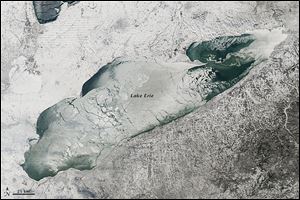
TOLEDO MAGAZINE
The Midwest endured a brutal winter
Subzero temperatures, record snowfall impact wildlife and waterways
3/30/2014

The Midwest has endured one of the worst winters in memory, with a conga line of Alberta clipper storms delivering relentless cold and brutal windchill temperatures, a heavy ice cover on the Great Lakes, and mountains of snow that buried the previous record. Although spring made its official arrival 10 days ago, we are still dealing with winter and its impact, on a multitude of fronts, and assessing the potential ramifications of all that snow, ice, and bitter cold on our wildlife and our waterways. As we reclaim the lakes, rivers, and woods with winter’s grip finally loosening, it could be months, until the annual wildlife surveys are completed, before the full impact is known.
PHOTO GALLERY: Click here
■ Spawning runs: The extended cold and heavy ice cover from this winter might push back the start of the spring walleye spawning runs in the Maumee and Sandusky rivers a bit, but not significantly, according to Mike Wilkerson, a fish management supervisor with the Ohio Division of Wildlife. “Those runs are pretty much driven by water temperature and the photoperiod (length of the day),” Mr. Wilkerson said, “and although the peak of the run might be delayed a little, the fish start to move into the rivers at pretty much the same time year after year.”
■ Fish kills: Lake Erie experienced ice formation earlier this winter, and to a much great extent than in recent years — there was ice more than two feet thick in some areas earlier this month. Since the water cooled earlier and stayed cold for a much longer period of time, a massive die-off of gizzard shad likely took place under the ice, according to Jeff Tyson, the Lake Erie program administrator of the Ohio Division of Wildlife. These fish, a common food source for many sport fish, are hyper-sensitive to cold water.

The satellite image above, taken by the NASA Earth Observatory on Jan. 9, shows the extensive ice cover on Lake Erie that developed this winter. The persistent cold temperatures and abundance of subzero days created ice that covered 92.2 percent of the total surface area of the Great Lakes on March 6, according to the Weather Channel.
■ Waterfowl deaths: Early ice and extended ice cover prevented several species of diving ducks from reaching their primary food sources, including minnows. This winter lacked the customary freeze-thaw cycle, and thousands of ducks have died throughout the Great Lakes region. Examinations of the birds pinpointed the cause of death as starvation. News accounts have documented hundreds of dead redbreasted mergansers and other waterfowl along the southern shore of Lake Michigan, and in Lake St. Clair, the Niagara River, and Lake Erie. “It’s a hard winter for ducks, like everything else,” Michigan Department of Natural Resources wildlife director Russ Mason told the Associated Press.
■ Wildlife losses: The heavy snows and harsh winters of Michigan’s Upper Peninsula historically have taken a significant toll on the white-tailed deer herd there, but that type of winter punch spread across much of the Lower Peninsula and Ohio this season. The potential losses in those deer populations are not yet known.
■ Lake levels: The extended cold, and the ice cover it created, limited water loss by evaporation in Lake Erie, and limited winter storm shore erosion.

An ice shove about 15 feet high, above, buried the lower tow path at Side Cut Metropark along the Maumee River in late February.
■ Bird migrations: The long-distance travelers from the tropics arrive later in the spring, so unless the cold persists, the biggest concern will be finding insect life to feed on once they arrive. If the shallow marshes warm soon enough, there should be ample midge swarms to feed the migrants, according to birding expert Kenn Kaufman.
■ Mosquito numbers: The bad winter will likely do little to limit our mosquito population, since enough of their eggs will survive and then hatch in the many pools left by melting snow.